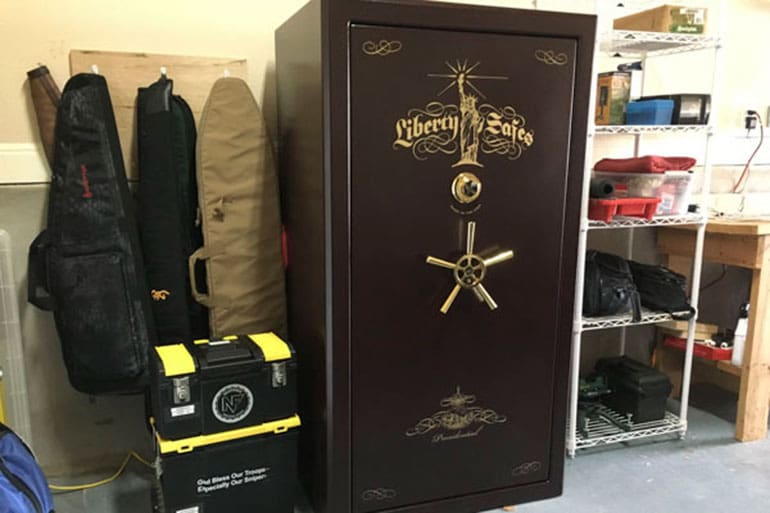
If you live in and love the firearms lifestyle, you assume the same basic responsibility — to keep your firearms away from people (kids, criminals, crazies) who shouldn’t have access to them. A gun safe will do that job for you, but how to choose one? Here are some helpful tips.
Size Matters
I’ve owned a Liberty touchpad-open gun safe in burgundy-and-brass for 20 years now, and it has sat in the corner of my office, quietly doing its job without complaint all that time. The closest modern equivalent is Liberty’s Presidential Series 25.
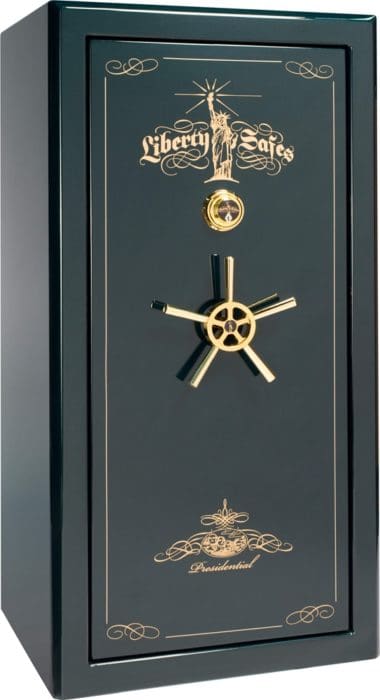
I also built a hidden gun room once I ran out of storage in the safe. I erred by not buying enough capacity initially.
Reason: What you don’t plan for — or at least I didn’t — was how much other stuff will wind up in the safe. Yes, I have a bunch of firearms in it, but there’s also all our important car and home documents, some cash, other personal documents, some ammo for the firearms in the safe, and assorted other goodies.
Also, my son and daughter have their firearms in the safe as well because they live in gun-restrictive states. They may never be able to possess their existing semi-auto rifles and shotguns unless they move back to Texas, so I’m holding them indefinitely, maybe a lifetime.
Door organizers can help cut down the clutter handguns can cause, but there’s no substitute for volume.
I’d say the smallest safe most gun owners will look at for their storage needs, depending on their situation, is a 24-gun safe, or more accurately, one that holds 24 long guns.
Keeping Things ‘Safe’
A good safe has to be durable enough to withstand the most common types of attacks: removal and sidewall penetration.
To start with the latter, the Liberty has enough sidewall thickness to satisfy me. It’s 7-gauge solid steel, but I believe a minimum of 10- to 11-gauge steel is satisfactory and a lot more affordable. What you’re trying to buy is enough strength that it’s drill-resistant or can fend off someone trying to puncture the sides with other tools, such as an ax or sledgehammer. Hopefully, you don’t store your acetylene torch in the same place as your safe.

Plenty of safes from major makers (Liberty Gun Safe 1776 Series 23, the Browning Sporter, and the Kodiak KSB5928EX-SO meet the capacity and side-thickness minimums above and won’t break the bank.
Simple removal is a bigger problem than you might think. If q thief who has targeted you has the means to slide the safe into a pickup bed, then he can open it with more aggressive means at another location.
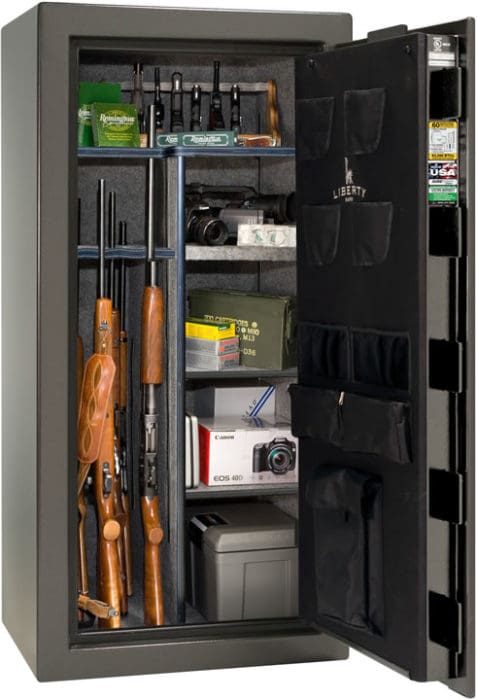
I had my safe bolted to the floor on a second story. Someone who wants what’s in it has a tough task of tearing it from the floor and getting it down the stairs. Probably too tough a job for most thieves. (Handgun safes should get the same treatment.)
Of course, that usually suggests professional installation. I had mine moved up the stairs by a local installer and bolted into place on delivery. If you plan to put your safe on the ground floor of your home, you really should have it bolted down, or someone can simply winch it into a vehicle and go to work on it elsewhere. Or, if the safe is light enough, the thieves can even use a hand truck to move it out of the building.
A lawyer I know put two 50-gun safes in his garage, both bolted to the floor, side by side. Effectively, they function as a very-difficult-to-remove 100-gun safe. He bought Browning Medallion Series.
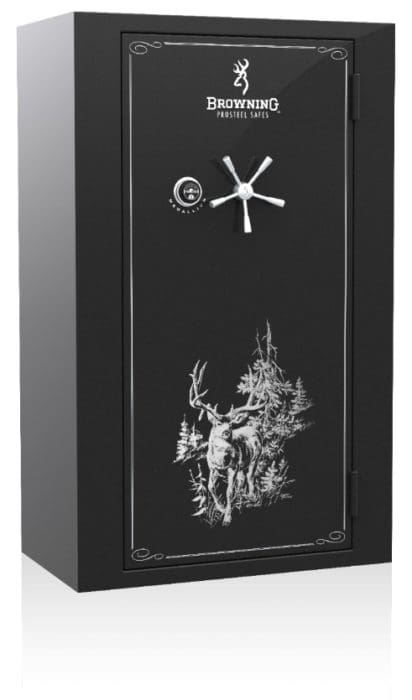
Next, The Closure
So, you’ve got a big-enough safe with walls that are thick enough to withstand attack. It’s bolted down to prevent it from being kidnapped. Now, how about the door?
You don’t want it to be easy to open, so look at how it is constructed in the crucial areas of locking bolts, hinges, and the lock type.
My Liberty has internal hinges that can’t be gotten to from the outside. Also, the steel door itself is as heavy a gauge as the sides, so there’s no flexing or weakness in the front itself. Also, the door is sunk into the safe body, which makes it more difficult to pry on. Before buying your safe, make sure there’s enough body steel under the door-seal lip itself, and that the edge doesn’t have any flex or wiggle.
Then, consider the bolts that fit into the safe’s body at the top, latch side, and bottom. You want as many locking points as feasible behind the door jamb to keep the door face from simply being ripped off.
Next, you’ll need to choose a manual combination lock, an electronic lock, or a biometric lock. Many shooters favor a mechanical lock because, like the argument over red dots and iron sights, they don’t want a lock powered by batteries that can fail.
Because I intended to be in and out of the safe a lot while I had children in the house, and part of my home-defense firearms were in the safe, I was more worried about how slow the manual lock was to operate, so I chose an electronic model that had a six-digit opening sequence.
I’ve had to change the batteries a few times over the years, which I admit is a PITA because the fragile wires under the keypad pulled loose from the connections, but I go several years between vexations caused by the battery updates. YMMV.
As I’ve viewed safe features over the years, I’ve noticed how various biometric opens have come onto the scene. I’ve tried them on quick-access safes and they’ve generally worked. Frankly, I’m not sold on them yet because I’ve been prevented from opening some safes because of a wonky alignment or dirty fingers. But they do offer speed of entry and allow for storing several fingerprints if you want others to have access to the safe.
Corrosion
Thefts and fires that damage firearms do happen, but both issues are sporadic. Rust is not. You simply must take steps to control corrosion inside your safe or you’ll wind up damaging your firearms.
If you think about it, safes will trap moisture inside because their very design makes ventilation difficult. To combat corrosion, you must clean and dry your firearms before putting them away. That wet duck gun can put water into the air in the safe and affect the other items in there.
TTAG has a few articles on the basics here, here, and here, or search the site for “how to clean your guns” to get a full lineup.
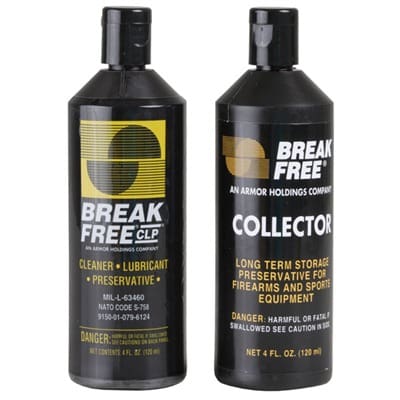
For guns that will be in the safe for extended periods, clean them as you normally would and apply a long-term solution to protect them. You can find several choices at Brownells, but I like the Break-Free Gun Collector’s Preservation Kit and Boeshield T-9 Waterproof Lube.
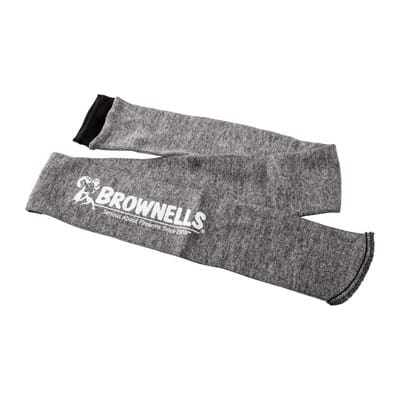
Using Brownells Gun Socks will protect your guns from scratches and dings going in and out of the safe, and the cloth is treated with silicone that inhibits rust and the fabric wicks moisture away from metal surfaces. Of course, an in-safe dehumidifier is a good idea, too.
Using adjustable shelving and racks in the safe interior can also help keep corrosion down. By separating the various firearms in the safe, it’s easier to keep track of them and keep them away from each other.
Wrapping Up
I didn’t touch on fire-resistant standards for safes because the makers promote many confusing claims about fire ratings, and a better fire safe adds dollars outside the job of preventing unauthorized access. But, in general, better fire protection means a better safe, so if you’re prepared to spend the dollars for enhanced protection against a gun fire, go for it.
With the advice above, you’ll be on the hook for somewhere around $1100 to $1600 for a big-enough heavy-duty safe with a lock style you prefer and a lifetime warranty, because this purchase will likely be with you for that long. There are both American-made models and foreign units in a color range from matte black to gray to cream white, whichever you prefer.
And you can improve from there. But even if you can’t buy the “best” safe possible, then buy something. Securing your firearms is a responsibility all gun owners should accept. In fact, some states, such as California, mandate criminal penalties for criminal storage of a firearm.
So don’t be “that guy” who didn’t take the right steps to keep the wrong people from getting your guns. Along with your safe, you’ll get some peace of mind along with your new gun storage.




A rule of thumb for how many long guns a safe will hold is to take the advertised number and cut it in half.
Optics play a BIG role in that.
I’d go a step further. You’re absolutely correct that the stated capacity dwindles quickly when you have grips, optics, slings, lights, etc. I’d also say to anticipate that your collection will better than double at some point. You should get a safe that advertises it can hold 4X your long guns, has shelves besides the long gun space, and then round up to the nearest number offered by your preferred company.
I have a Bighorn safe with a swing out rack. That rack is awesome because it pretty easily accommodates slings, scopes, etc and when swung out, you gain easy access to the guns behind it. I then got creative and mounted magazine racks on the wall capable of holding 30 mags behind the swing out rack, a magnet to the top of my safe for my AK pistol, and my Ruger 10/22 takedown sits on the floor beneath the rack. I bought a pair of pistol holders that mount on the inside of my door that hold 8 each and make good use of the shelves to hold more pistols and ammo.
It wasn’t enough. I’m now looking at a safe with an extra foot of height, that can accommodate TWO swing out racks and has shelves besides. Unfortunately, the one I’ve settled on is about as expensive as renovating my kitchen. Unless I can convince the wife to free up tax return money, I may have to sell some guns to cover it…. which lessens the need for a bigger safe
I’ve read that a really strong magnet will energize the relay and these can be ‘cracked’ in less than a minute… Anyone else heard the same??
I’d say that if you knew about the safe, it’s weaknesses, and came prepared to crack it before robbing a person…. it doesn’t matter whether it’s a magnet or a cutting torch, the safe probably won’t hold
But a cutting torch would take a considerable amount of time.. I was speaking specifically about electronic keypad locks…
I’ve heard that mechanical locks are the only way to go because Neodymium magnets can be run across the door where the relay is mounted and once the magnet is over it you can hear hear it ‘click’ and then turn the lock and disengaging the steel bolts… This all within a minute, two at the most.
Again, I don’t know if this is true. But that is what I have heard in the past.
I don’t know about a magnet opening an electronic keypad. I’ve never heard a robber saying they carry any type of magnets in case they run across a safe they could open.
What I meant, and I probably didn’t say this too clearly: if someone knows you have a safe and has prepared to get into it, they’re probably going to be successful. Yes a magnet is quicker than a cutting torch. Probably better for the guns inside too. But you’re still looking at someone who knows you, your house, your safe, probably your schedule, and has prepared in advance. I don’t think there’s a commercially available safe that can hold.
Safes are good against curious children, smash and go robbers, sometimes fire and sometimes flood.
I say this every time a gun safe article is posted. I have an old school, robust, tumbler-only safe. I will never use anything that employs touchpads, electronics, batteries, or (God forbid) Internet connectivity.
One of my newbie POTG buddies got his first handgun recently, along with an AR. He then bought a very slim standing safe (anyone can easily pick it up and take it if they found it) from some online vendor that uses a battery-operated touchpad and a backup key in case the batteries die. He promptly lost the key. I asked him what his backup access plan in now. He said, “I hope I don’t forget to replace the batteries.”
Nothing wrong with a tumbler lock on a safe. I have an electronic keypad on my safe. I also have some optics that run on batteries. I put them on a one year rotation and once a year I swap all my gun related batteries out.
Organize your gear outside your safe IMO.
Beyond theft a safe comes in handy should damage to the home be weather related, etc. Recently we had a large Pine break in half during high winds and it came close to doing some very serious damage. Tree looked healthy but was weakened by unseen rot half way up, insurance covered minor repairs and clean up which we did. Our home looks like a gun free zone because the least amount of people who know or suspect you have firearms the safer your safe will be.
I reject your claim that the gun owner is responsible for keeping their guns locked up to prevent criminals from getting access. You are continuing the narrative that the gun owner is the bad guy when a criminal breaks into a home and steals things. All of my guns are locked up in a safe far better than the safes described here, plus additional layers of security. But it has nothing to do with any kind of responsibility on my part to place limits on what a criminal can steal from me.
I agree. I’m not a fan of victim blaming. A gun outside a safe is not an invitation to steal anymore than a short skirt is an invitation for r@pe.
It’s an interesting line to walk though. If my car gets broken into, guaranteed the cops will ask if I had the door locked. And I probably SHOULD lock my door as a deterrent. But how do you stress ways to protect yourself against crime without blaming the victim of a crime?
Using a cutting torch to open a safe will be hazardous if bulk powder is stored inside by the hinges and lock point. Put the safe contains back powder sticker on it.
Decoy safes are a good option as well.
I’m shopping for another safe now. Was in Tractor Supply last Friday. Hitting Bass Pro and Sports Authority tomorrow. It’s just time. One thing I’ve learned. You can buy a good safe for the price of a good rifle. Even I can do that math.
Not knowing about the “divide advertised capacity by half”, I ran out of room as soon as I got it home. My “12 gun” safe holds only five rifles with optics and a shotgun, and leaves no room for more than three pistols. The only ammo in there is the loaded mags in the door pockets. That leaves all of my black powder pistols, “a number” of cartridge revolvers/pistols, a Sharps target rifle (which wouldn’t fit in there anyway because it is so long) and a musket sitting around the house, plus all of my ammo.
Oh well, you live, you learn.
Similar story here. Inherited a very sturdy safe years ago. Can hold 12 rifles and a stack of handguns. Uh-huh…sure. You mean like how a “6-person” tent can hold six people if they’re all skinny, arranged like sardines in a can, and there’s nothing else in the tent such as backpacks or supplies?
I was able to “Tetris” eight in there, and that’s with no extra room to spare. A dessicant canister is strategically placed on the interior’s floor, and the only shelf (at the top) holds only two handguns because I thought “hey…this will be a great place to store the silver coins, extra cash, and backup digital drives”. So I had to buy two separate multi-handgun cases. Then there are all the mags…and gear…and targets…
Oh my. I haven’t even mentioned all the ammo cans yet. I wish I could afford a new, massive safe that could hold everything. It’d have to be like a small room.
One ergonomic consideration when getting a safe is lighting. If it is going in a closet or somewhere else dark then paint the interior white prior to installation (or cheap wallpaper). A couple quick and sloppy coats of white paint will make it a lot easier to find a particular item in the future.
Secondly get one of those cheap LED lights that looks like a light switch and mount it to the interior.
Which gun-cabinets are most recommendable for apartment renters?
This page had a nice review of an assemble-in-place safe a few years ago. Can someone recall the brand?
SnapSafe, now owned by Hornady.
Not mentioned in the story is flood protection. Both of my basement safes sit on 5 1/2″ poured concrete bases (cuz that’s how high a 2×6 form comes out to) and bolted down with stainless 1/2″ anchors. In case of a serious home fire, you’ll end up with an unbelievable amount of water standing in your lowest level, and a heated safe will turn into a vacuum when water hits it. Also, open it up asap after an event to clean the contents well. Oh, I also agree on the four times what you think you’ll need rule.
Did the same thing for some of same reasons because I grew up in a house with a wet basement. Except I used cinder blocks and mastered them down. I’m lucky enough to have a inside corner due to concrete guys or framers not being able to measure the joists so I was able to basically create a “closet” with no doors that swings out of the way on overhead barb door style tracks to expose my two safes(one tactical, one recreational). It’s a nice hidden setup, it’s really a shame I can’t go around showing everyone all the time.
Nothing I saw listed above is a safe. They’re Residential Security Containers. They’re fine for keeping honest people or inexperienced junkie out. An angle grinder, fire axe, or pry bar will bust them open since they’re relatively thin sheet metal and drywall. Check out YT or search DDG to see how easy it is to get into them, and how a real safe is made and rated.
Correct . Tl30 and above for me .
And don’t fill them up with every valuable from all over the house, making them a nice Easter Basket for the bad guy.
For ammunition, I use a contractors job site tool chest.
I took the money for a really nice safe and converted a large interior walk in closet into a gun room. Complete with fire resistant wall board top to bottom and a reinforced steel door and frame. It holds plenty of firearms related items. Rule #1 at our house. If it catches on fire Run Fast Run Far and don’t let anyone near it for at least 30 minutes.
there were originally two, snapsafe and zanotti… but i think dakota also makes a modular safe now. the pro is that they’re able to be dismanted however they are still very heavy, with the safe door (having the door bolts) being the heaviest
Zanotti has no fire lining and claims only 20 min fire (self rated). 20 minutes is nothing. They don’t even have a door seal and smoke is acidic. They have a video up now of one from a fire with only an old guy saying “All my guns survived” with no proof.
They are way overpriced for what you get also, especially when you add in shipping.
Zanotti= No fire lining, no door seal, no replacement guarantee. 11 gauge American made with a good manual lock and no bogus key overide.
Snapsafe= Made in China. Self tested fire lining (Something is better than nothing in my mind). Shipping Incuded in price . Safe replacement guarantee in fire.
Made with two layers of 14 gauge steel that they proudly call 9 gauge. I cannot find anything about the strength of layered steel but I believe solid is much better in an attack.
They have an electronic lock with a hole drilled so you can unlock it with a skeleton key. That is a serious security weakness. But we aren’t looking for real security right? Just the “Feeling” of security.
Overpriced for what you get.
I don’t take any chances with the battery. Changed every year with a new (I check the date) lithium battery.
Just a personal preference, but I would not buy an electronic safe that did not have a manual override, preferably a combination override. Should Putie carry out his threat to nuke folks helping the Ukrainians, I am confident that we will be the first to know. I believe the attacks would be EMP attacks as opposed to nukular bombs aimed at population centers. That means there would be no nukular winter and other countries wouldn’t have to worry about fallout. In the event of an EMP attack, if you are in the zone for the attack, I think you might find your firearms safely locked away without a manual override. Having a combination override is better than a key, just noting the example listed above about the new safe owner losing the key almost immediately. I wouldn’t keep my home defense firearm in the safe any time I would be home. My firearm is always within reach the entire time I am in my house. If little kiddies are visiting, then it is on my person. I do know how to spell nuclear, I just like to channel George Jr.
Comments are closed.